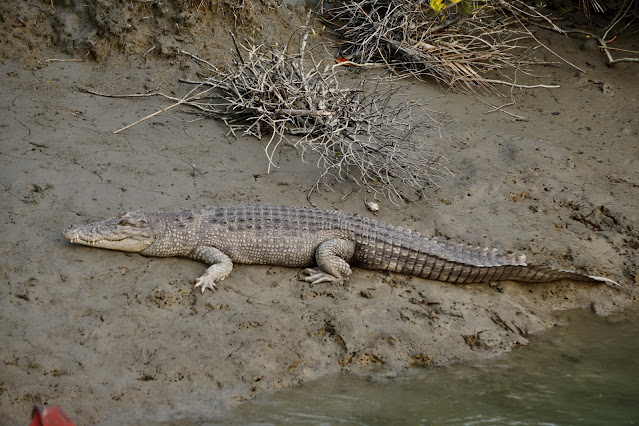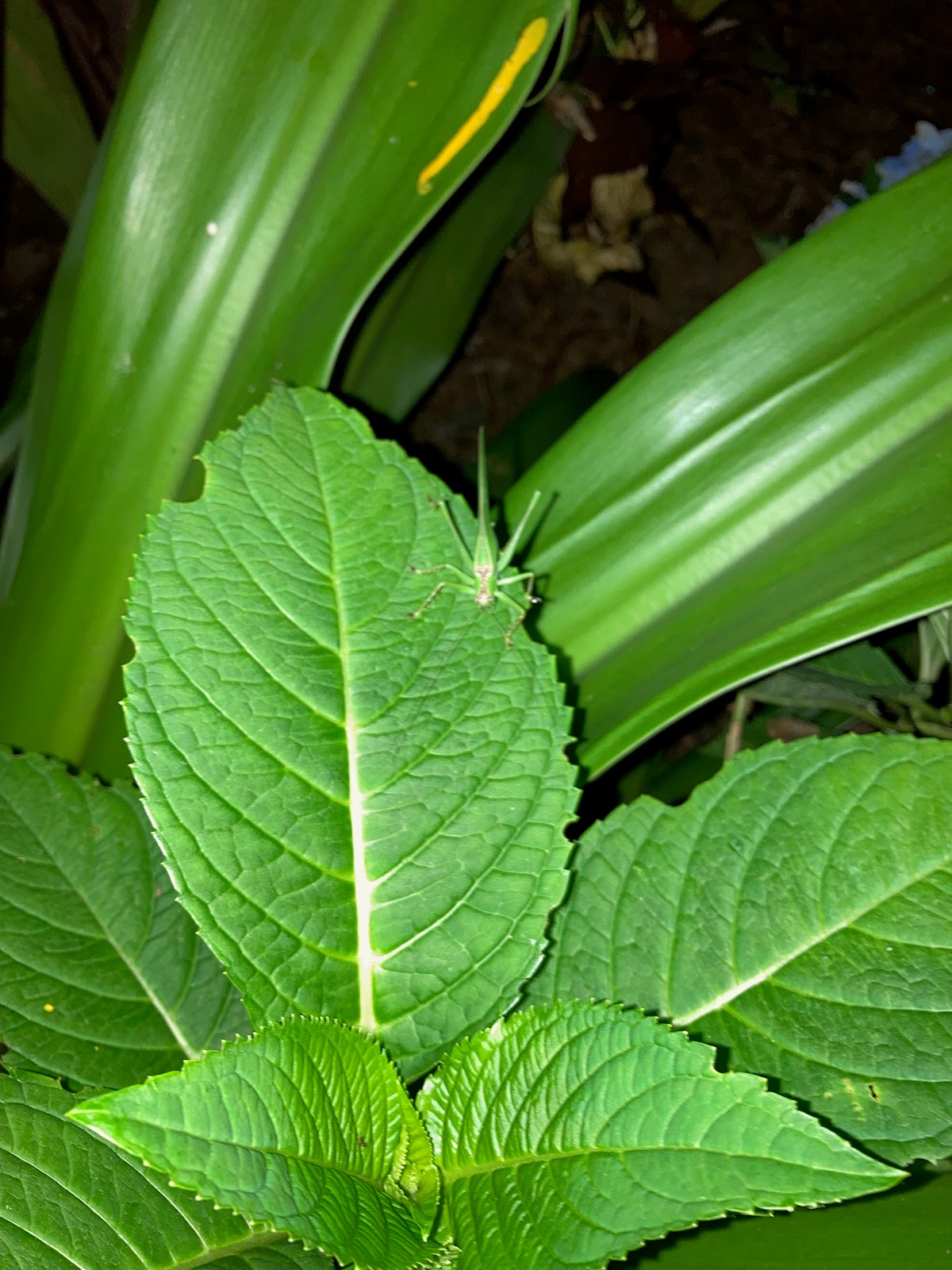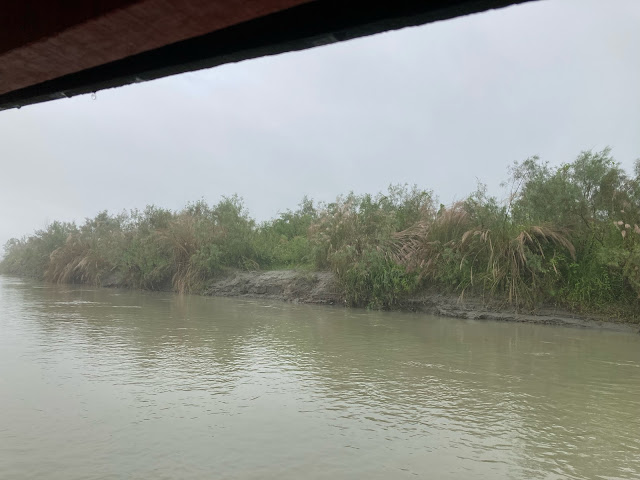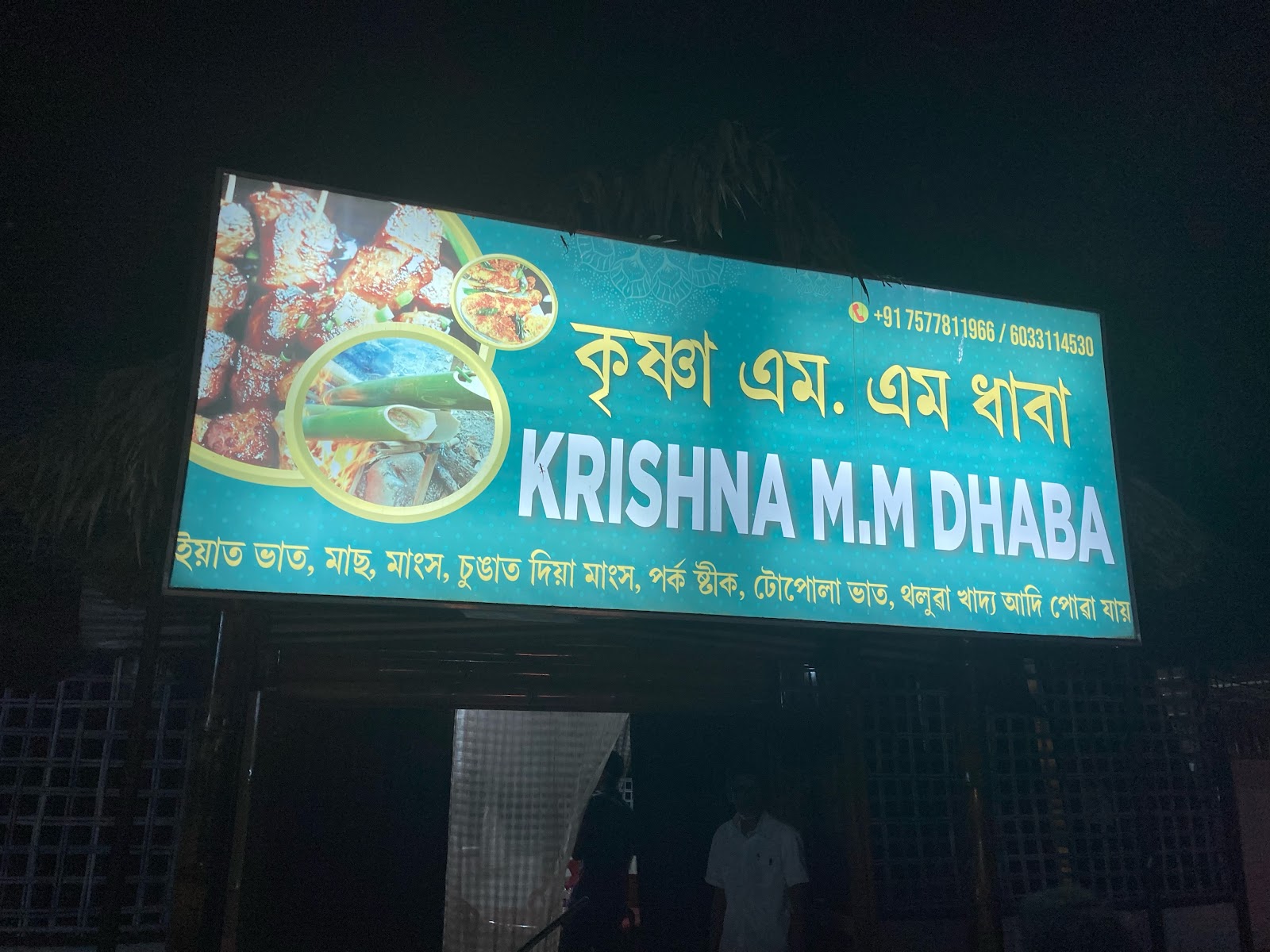Hrishu was the only minor/child on our trip, and gamely put up with our ways, adding a wry comment here and there. (All others, children at heart, yes yes.)
This is such a beautiful summary - that I want it here, so I can refer to it at anytime. Added a few pictures here and there. (Picture captions and sarky comments are mine, so please do not blame "Kutty" (as Raja called him).
MNS Mishmi Hills and Assam Trip Report
September 30 – October 09, 2022
I woke at 1:30 am (to catch the flight for the trip), not too sleepy to be excited. I had jumped at the chance to go on this trip. I mean, initiation into serious birding with a trip to the Northeast?! Two flights, a magnificent view of the Brahmaputra, and 9 hours later we reached Dibrugarh airport.
 |
| Brahmaputra Views from Flight 2 - Kolkata to Dibrugarh |
Day 0: We were welcomed by Mr Hiranya, one of our tour managers. Each of us were greeted with a traditional gamchha by our car drivers. Vijay uncle had already assigned us into groups and to cars, so all that remained to be done was to board the car. It was a four hour drive from Dibrugarh to Roing. Mr Probin Hatibaruah, our bird guide, joined us on the way.
 |
| Tea plantations once we left Dibrugarh |
After a stop for lunch, we reached Bhupen Hazarika Bridge, where we had been assured we would see vultures. We did indeed see them. There were about 10 to 15 individuals each of White rumped vulture and Himalayan griffon vulture. I spent a very happy 15 minutes watching them soar from an unknown position and circle down into the grass. It was quite a spectacular way to start the trip.
 |
| Spectacular shots by Suresh. There must have ben a carcass in the distance, and the area was like a busy airport, as these magnificent large birds circled and landed. Once they landed, I could not see them. They are one of the largest Gyps |
 |
| Once again, Suresh. |
 |
| The river and bridge were spectacular. I loved this patch of grass, in full flower, in the middle of the Lohit. |
 |
Sadiya, Assam, on the other side of the bridge - where we stopped for chai.
|
 |
| We all met Probin da at the tea stop. |
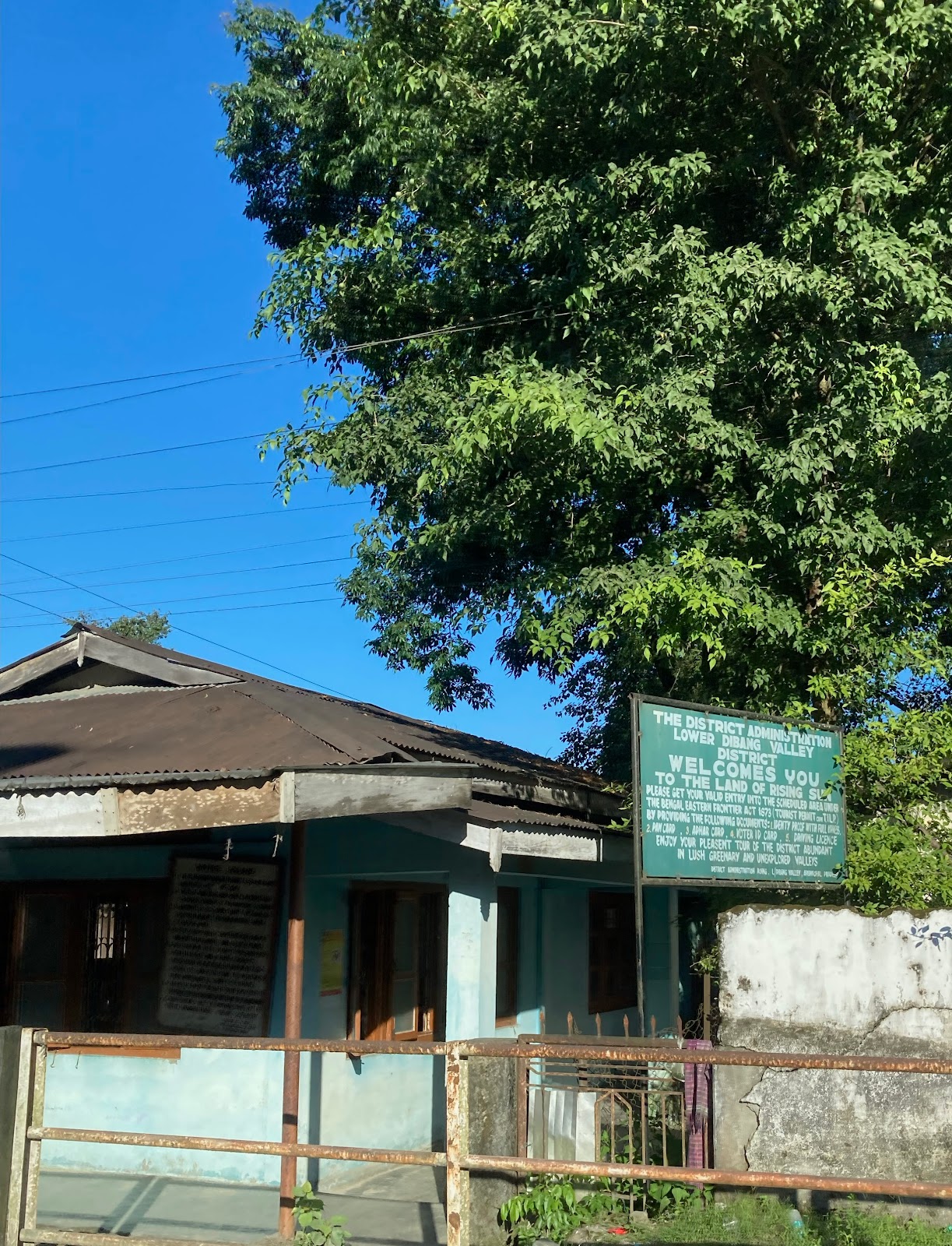 |
| Arunachal! |
 |
| A first glimpse of stilt long houses. |
 |
| The hills! |
We reached Yatri Niwas (our hotel in Roing) at about 4:30 PM by which time it was already getting dark. We were met by Mr Pralay, and a flock of Eurasian tree sparrows. After settling in we left for the other base - Dibang Valley Jungle Camp. After a mothing session we had our dinner, and retired for the day.
 |
| Yatri Nivas by night with a panchami moon. (Navaratri week, remember.)
|
 |
| One of the moths we saw that night - see how well it goes with Yuvan's veshti border. The said veshti was burnt by the end of the night. |
Day 1: I woke up at 4:30 AM and was surprised to find it bright. We met Mr Jibi Pulu, and left for his camp to learn about his work to save Lower Dibang Valley from a Hydroelectric project. A slightly harrowing drive - five stream crossings - later, we reached the community conserved area created by Jibiji.
After our breakfast of bread sandwich and puri, we entered the land of giant wood spiders. They were ever-present along the side of the road and made huge webs that caught the sun beautifully.
 |
| Beautiful webs, strung across and above our paths. |
 |
| Giant wood spiders everywhere, undisturbed webs, marvels of symmetry. |
 |
| With a catch as well. |
Avian fauna was surprisingly nonexistence, but the plethora of butterflies ensured they were not missed. We saw a White dragontail, Orange oakleaf, Golden birdwings, and other species like sailor, bluebottle, and several Mormon species. The most common butterfly was the Large Yeoman.
 |
| Sailor on Suresh's camera. |
 |
| The camera was busy capturing the Yeoman |
 |
| The endemic forktail which got Yuvan all excited. A beautiful little butterfly which was busy mud puddling. |
All these were seen while walking on the track through tall evergreen forest and, for a short while, grassland. We got to wade through two streams but turned back on Jibiji’s advise. Jibiji told us traditional Mishmi tribal stories of Gibbons, tigers and takins on our return walk.
 |
| It was hot when we returned to the camp, and we spent the afternoon under the shade - one set under that green verandah and another on the opposite side under the trees. |
We saw an Oriental honey buzzard during lunch. We left for Sally Lake (for tea), doing birding on the way. The notable sightings were Emerald dove, Blue throated barbet, and Sparrowhawk.
 |
| Suresh captured this beautiful Birdwing on the return. There were many flitting through the Rees, looking like birds, so huge were they. |
 |
| The flowers they were nectaring on. |
 |
| And the Popinjay we saw at regular intervals too. |
Sally Lake
At Sally lake the only bird I saw was a Long tailed minivet, and that was the last action of the day.
 |
| Sally Lake - a beautiful little natural lake, which one accesses above, and see the lake and the woodlands around. We were tired, and there was a rather delicious tea that became favourite with the group. |
 |
| Prayer flags stretched across, and away from the chatter and laughter of our group, the lake was serene, but very quiet, no tweets and chirps, very odd. |
 |
| there was no one besides us at the lake. We were happy and tired. Sat around on the benches and then trooped into our cars and headed back. |
Tiwarigaon trails Day 2: The plan for the day was to do roadside birding on the Tiwarigaon trail. The road travelled through dense evergreen forest with tall trees and fishtail palms.
 |
| Every morning we saw a family of ducks either waddling besides the road, or bathing in the little puddles in the road. |
 |
A reluctant piggie being taken for a walk- a common sight, but quite amusing on our first morning drive.
|
We began the day by seeing a Common buzzard. We saw Grey treepie, Long tailed sibia, Streaked spiderhunter, and Orange bellied leafbird, all before the road went into real dense forest. We also saw a flock of Russet sparrow which we mistook for Rose finch initially.
 |
| Buteo buteo - Common Buzzard - Ravi's picture |
 |
| Sheila's spectacular shot of the Common Buzzard in flight. I wonder if this is the winter visitor or the resident Himalayan subspecies? |
At a nice viewpoint, Probinda pointed out the rivers visible. We had our breakfast then, and I spotted a Crested serpent eagle.
 |
| The river valley with all the rivers. |
 |
| White Bauhinia on our walk. The vegetation was "tropical evergreen", at this height. Several Terminalias and Albizzias |
On our drive to the next stop, we heard
Hoolock Gibbons and one of the drivers spotted the troop. After a bit we saw them on the opposite slope. One gibbon demonstrated his swinging prowess. A little further another troop treated us to a concert. We couldn’t spot them but we did see a White throated fantail.
Some of the cars hadn’t stopped and missed the gibbons but they saw several small forest birds and a Mountain hawk eagle. After we joined them, we saw Nepal fulvetta, Hume’s bush warbler, Grey chinned minivet and Small niltava among others.
Much to Yuvan anna’s delight, the butterflies had come out now that it was hotter. Birdwings we found aplenty, as well as the Red lacewing, Paris Peacock and others. That portion of the day was devoted mostly to butterflies, though we did see the Little spiderhunter and heard the Rufous necked hornbill.
 |
| A stick insect on the roadside led to much "Q&A". Arjun asked "how do you know its an insect?". Yuvan says with rolling eyes - it has 6 legs. Arjun persists (and I had to say I agreed with Arjun) - it could be a stick with 6 branches. Yuvan gave up and walked away. The said stick insect walked, at this point, and the argument was settled. |
The new Anini Road and viewpoint |
The new Anini road is not open for traffic, there is blasting still going on. The hill and rubble looked so fragile.
|
 |
| So while behind us was a blasted and bleak hillside, on the other side was this. The beautiful grass flowers and the valley below. |
In the afternoon we drove to the new anini road. As we were driving Probinda saw a Parrotbill. We heard it but couldn’t spot it. We also saw a Sultan tit. At the new anini road I was surprised to find out that Grey wagtails have a lot of yellow plumage. We had a great view of both male and female Blue rock thrush, and the sunset.
 |
3:57 PM - the clouds, hills and river below catching the light. It was a time for pictures, just breathing in the scenery and being humbled by the river valley.
 | | 4:47 PM - a blaze of glory above, but dark shadows below. For some reason I dreamed of the Kaziranga floodplains that I had seen a couple of years earlier. |
|
Jia Grasslands
Day 3: I woke at what had become my usual wake-up time, ready to see Parrotbills. We were going to Jia grassland to try and spot them. We were unsuccessful. We heard the call but couldn’t spot the bird. We did see the Stonechat, a few Doves and some lovely flowers and dragonflies. Probinda told us about the Parrotbills and how they need three types of grass to survive, and about gibbons. We made our way to a river where we saw White rumped munias. I saw a Marsh babbler (Probinda identified the call). We returned for breakfast during which we saw a Brown shrike.
 |
| The seeds of the grass - beautiful picture by Ramesh. |
 |
| Hanging back, to go "around the corner", and I saw this - Is it a Common Batwing? |
Our next stop was Sally Lake. On the way however, my car (which had Vijay uncle, Ramesh uncle and Yuvan Anna) turned off to the Riwatch museum, which Jibiji had recommended we visit. Jiten bhai (our driver) managed to do a full 360 degree turn when we saw a signboard that said “Monday closed” but decided to continue. Vijay uncle was successful in having the museum opened and we saw Idu Mishmi weapons, headgear and other cultural items.
Sally Lake again
After we finally reached Sally lake we found it to be a moth paradise. After photographing the moths everyone returned to their rooms.
My father and I took a walk around Dibang valley jungle camp before lunch and saw several butterflies, including a Common palmfly.
After lunch, Probinda led us on a walk around the camp. We spotted Maroon oriole, White rumped needletail, Spangled drongo and, best of all, a snake - the Mountain keelback. Around 5:30, we left for sally lake again, this time for a mothing session. The morning’s moths were still in the same position. The light attracted more cicadas than moths but it was an interesting half hour nonetheless.
Tiwarigaon trail again - further explorations of the Mehao Wildlife Sanctuary
Day 4: Having got 20 more minutes of sleep than I expected (the delay in leaving was because of a water problem) I was well rested for the day’s birding. It was a cold and overcast day. We were going to a place called 40 km point and would bird while walking back. It was 1800m high and the vegetation appeared a little different.
 |
| 6am - Tiwarigaon and beautiful mist and hills. Magical and mystical. |
 |
| The Gaon was always shut. Or maybe we were always crossing it at a "shut" time. But the layers of hills and the mist always drew my eyes away from the village. |
 |
| I think this is the Indian chestnut - "Hingori" - in Assamese. |
 |
| Every step had wonders like this. At this height, different vegetations |
 |
| How to not photograph at every turn? Honestly, I did not miss the birds, and was too distracted to focus on searching for them. |
There were more orchids, ferns, and climbing plants. Some notable birds we sighted in the morning were : Himalayan bluetail, Yellow bellied fantail and several Yuhinas.
 |
| Chekopani bridge - breakfast and rain |
As we reached Chekopani bridge (where we had our breakfast) it began raining. Despite that, we saw Plumbeous water redstart, White capped river redstart and Little forktail at the bridge.
 |
| Plumbeous Water Redstart - A lovely photo by Meera |
 |
| Plumbeous Water Redstart - Photo by Ravi |
 |
| White capped river redstart - Photo by Ravi |
 |
| Photo by Ravi - Little Forktail - My lifer. And my first forktail. |
 |
| Each of us on our own journey of discovery and delight - Photo by Ramesh. |
To get out of the rain and the mist which had rolled in, we drove down and (once we were out of it) began birding again. We spotted Scarlet finch, Red tailed minla, two Sunbirds, Grey headed canary flycatcher and Beautiful sibia. We also saw the Mountain bulbul and Blue throated barbet.
 |
| Scarlet Finch I did not see - Photo by Meera. (one of the many birds I missed as I stared at undergrowth and other such things.) |
 |
| Further down the Anini Road. A bridge across the river was coming up. Rubble everywhere, uphill. |
 |
| Beautiful stones like this ripped from above, and lying exposed. I mused by how many people will benefit from the bridge. Was there a better way to do it, though? |
 |
| Yuvan and Hrishu up on the hill side watching the mud puddling butterflies. |
After lunch we left for the new anini road; however this time we were going further than we had two days ago. We found a butterfly-mudpuddling spot on the anini road, and Yuvan anna refused to budge from there, so our car followed the rest minus one person. The area near the bridge had fantastic views, but the only bird we saw was a Collared treepie. When we picked up Yuvan anna later, he showed us both White and Green dragontail butterflies.
 |
| Usha says she just gasped when she saw this moment - discovered by Meera. Paris Peacocks mud puddling - Photo by Meera |
Meera aunty had seen another mudpuddling site and had told the group. We stopped there and found more than half a dozen Paris peacocks and a couple of Yeomans and Bluebottles. I returned to my room dazed from the butterfly sightings.
Mayudia Pass breakfast encounters here
Day 5: I found that it can be dark in the mornings in Mishmi, when I woke up at 3:15. The plan for the day was to go to Mayodia pass. Unfortunately the only birds I saw were a White and a Grey wagtail. They were the only birds who came out on a day in which only demented penguins should be out and about. It began to rain during our drive and was quite heavy by the time we reached Mayodia. We took shelter in a two room hotel (maya hotel). The grown-ups drank tea while I assuaged my hunger with biscuits - breakfast being in the one car (which also had my dad) that had gone ahead. Eventually the cars’ passengers joined us and we ate.
Yuvan anna had been talking to the locals in the kitchen about climate change and we learnt that snowfall had reduced over the years. I ventured out after breakfast and got soaked by a horizontal spray of rain. I went to the kitchen to warm myself at the fireplace/stove and found others with the same issue. Yuvan anna’s attempt to find out what wood the fireplace was made from ended in confusion and laughter - “ye konsa ladki hai?” Gayathree aunty fared better and translated the reply, which had Yuvan anna wondering whether to laugh or cry - “it comes from a tree.” We left Mayodia and returned to our rooms because the rain wouldn’t let up. On our way back the breakfast car got a puncture (thank goodness it didn’t have lunch) which delayed them.
After lunch a group played the wilderness game and I spotted a moth. After a wait, for Yuvan anna to be free, I got the moth ID’d as Jerdon’s window moth. A few people visited the market and the Riwatch museum, but I was done for the day.
 |
| The Wilderness game is available for sale - click here. It was great fun. Yuvan had a tough time trying to get us aligned to the rules of the game - each of us wanting our own rules. Devika insisted she need two turns, Gangapriya wanted to show everyone her cards, Usha kept things close to her chest, I nitpicked over descriptions, and Yuvan tore his hair! (Easier to teach kids, he must have thought.). Anyway, it was strategic Usha who "won", creating a strong eco system before the rest of us. |
 |
| Moth on light |
Day 6: I woke up late as there was no morning birding and made the 20 minute journey from Yatri Niwas to Dibang valley jungle camp for one last time. We ate breakfast and played wilderness as it was raining relentlessly. Suresh uncle was taking photography classes (I joined for a while), and some others had braved the rain to bird in the camp.
Elu uncle called me for a walk around the camp. We saw the Red necked laughingthrush, Rufous woodpecker, White rumped munias, Bulbuls, Swallows and more. We also saw several butterflies including the Purple sapphire and a few Five rings. We actually saw the Rufous woodpecker very close to the dining room, but it flew off before anyone else could see it. I spent a little while perusing the Salim Ali 10 volume set (to ID the birds) kept at the camp dining room.
Moving On and away from Roing
We set off for Digboi after lunch. On the drive we saw Oriental Pied hornbills, Honey buzzard, Green billed malkoha, Hill myna; I saw a Black capped kingfisher as well. Upon entering our rooms (verandas, to be precise) we were greeted by a double rainbow.
 |
| The rainbow at Digboi - I saw a single. |
 |
| We were in the 3rd floor apartment, along with Ravi and Suresh, and these Asian Pied Starlings were in our eyeline. Photo by Ravi. |
Several people decided to visit the Digboi oil museum. I chose to stay behind and instead saw a Barred owlet in the garden. Unfortunately it was dark and I couldn’t get a good photograph. I had also spotted a Shrike and White throated kingfisher earlier. At dinner, I confirmed (from more knowledgeable people) that I had indeed seen a Black capped kingfisher and a Barred owlet, after checking if the owlet was still in the vicinity.
Dehing Patkai - and the gibbons
Day 7: We set out for Dehing Patkai at around 5:30 am. As we neared the park, we saw an emerald dove, and a little before the final turning to the national park we saw a group of Hoolock Gibbons. There was a male, a couple of females, and a baby too, feeding. We spent some time watching the antics of the gibbons and observed their feeding.
 |
| The Gibbon male on the kadamba tree, looking at us. With fruit in hand - Photo by Ramesh |
 |
| The Gibbon Male - Photo by Meera |
 |
The female Gibbon, lighter brown. Photo by Meera
|
We also spotted a Lesser yellownape.
After breakfast at the entrance of Dehing Patkai we set out for the morning walk inside the national park. Three forest guards accompanied us. We walked on a leaf covered path in dense lowland rainforest comprised of tall dipterocarps. There were also a lot of ferns. We spotted a Great hornbill in flight and heard the Brown hornbill. We also saw the Rufous woodpecker, both Lesser and Greater racket tailed drongos, Black headed cuckoo shrike, Sultan tit and Woodshrikes. We heard the Grey peacock pheasant and a few people saw the Khalij pheasant. On our way back for lunch, we spotted a Crested serpent eagle and a troop of Rhesus macaques. A little further down the road we had the luck to see a Pied falconet eat a bulbul and then fly into a tree, possibly to catch something else.
We returned to Dehing patkai after lunch to look for the Trogon. We were greeted by the sight of mudpuddling butterflies on what Probinda later said was leopard scat. About 5 minutes after we began walking the afternoon bird activity began. We saw Large and Common woodshrikes, Grey headed woodpecker, Chestnut bellied nuthatch, Sultan tits, Blue winged leafbird, and others. We also saw a Tropical swallowtail moth. Earlier in the day we had seen a False tiger moth. Other Lepidoptera we saw included loads of Barons and Archdukes, Grey counts, Golden angle, Yellow helen, Common tit. Suresh uncle photographed a Fluffy tit. After we went a little way up one path we turned back and tried another. This time we did see the Red headed trogon. It was sitting inside the tree but one could still see it. I was delighted to finally spot it after all our efforts. On our way to the car we saw Blue bearded bee-eater When we returned to the car, we found out that Yuvan Anna, who had turned back earlier to see the butterflies, had not only seen a pair of Trogons, but also a Green magpie and Khalij pheasants. Arun uncle had seen the Trogons earlier in the morning as well.
(My Dehing Patkai narrative here.)
We left Dehing patkai for Tinsukia reluctantly ( at least in my case). As I was in the back seat I dozed off and didn’t spot anything else.
Maguree beel wetlands and the Dibru Saikowa national park
Day 8: This was the last day of birding on the trip. We were going to the Maguree beel wetlands and the Dibru saikowa national park. We set out with packed breakfast. Neither mine nor Yuvan anna’s lasted the drive. Much to Ramesh uncle’s and Vijay uncle’s relief we left theirs alone.
We reached Maguree Beel and got into the boats only for it to start raining. We sheltered in the cars and after some discussion, Vijay uncle announced that we would go to Dibru Saikowa first.
We reached Dibru Saikhowa and got into a big roofed boat.
The rain had lessened. I was in the lower deck and shortly after we set off saw a Striated heron. After a bit I climbed to the upper deck and was rewarded with the sight of a Greenshank. We also saw Lapwings, Swamp francolins and a Grey headed fishing eagle. A large flock of ducks, comprising Lesser whistling and Indian spot bills, was sighted. Apart from that the trip was uneventful.
 |
| This beautiful picture of the rising mists by Ramesh |
 |
| Brooms! Lined up on the banks, from the grasslands |
 |
Canebrakes - another unique aspect of Dibru Saikhowa National Park are the little islands of Elephant grass.
|
 |
| The Grey-headed Fishing Eagle- picture by Meera |
 |
The mixed forests I am sure had many hidden treasures.
|
The rain had stopped so we returned to Maguree beel. The boats here were pole boats which looked like canoes. As we boarded them it started drizzling but cleared up as we left. There must have been something about that docking place because it drizzled again when we landed on our return. We set out in spite of the drizzle and it was worth it. I think this must be the best way to bird in a water body. We could get right inside the water body, at water level and moving at a gentle unobtrusive speed without disturbing any bird. Once the sun came out it was even pleasant to sit on a wooden plank. During our boat ride, we saw the Striated grassbird, Ruddy breasted crake, Rusty rumped warbler, Rosy pipits, both the Bronze winged and Pheasant tailed (without the tail) jacanas, Temminck’s stint and a Darter. Naturally there were loads of Herons, Egrets and Cormorants; Barn swallows and Wagtails too.
 |
| Our lunch halt - nice fresh and simple food. Every meal we thoroughly enjoyed, and it is best to eat local food rather than the pan Indian ubiquitous PBM. |
After lunch we went on a short walk where we saw Moorhens, Jacanas and saw several dragonflies and damselflies.
 |
| The views on the walk. |
(Picture wing dragonflies in hundreds!)
Some of us went on a second boat ride. This was even better in the afternoon sun, drifting in between water lilies and hyacinth. This time we saw a lot more Jacanas as well as Little Grebe and a pair of Cotton pygmy geese. A Pied kingfisher enthralled us with its dives.
After some hot pakoras, we said our goodbyes to Probinda and returned to the hotel. That night we had a special Assamese thali in an authentic Assamese family run restaurant.
Day 9: After last minute packing and breakfast we left for the airport. We said our farewells to our drivers, Pralayda and Hiranyada. Also there to see us off was a White wagtail.
A few words on the food. The food was simple, tasty and filling although a tad spicy to my palate. The local greens were interesting. And curd was provided!
Probinda was a mine of information not only about birds but about the myths and folklore associated with the hills. His mimic of the gibbons was amazing and hilarious. His whistles were awesome. Pralayda had amazingly deep knowledge of trekking and wildlife in addition to his tour management skills. All the drivers, Jiten, Dhanonjay, Thakur, Moon, Mintu, Shamim and Prashanto were very cheerful and helpful and patient with the boisterous group.
This was a memorable trip (not just because it was my first one) and one which I would like to repeat with the same group. There is so much more to see, which we couldn’t this time, for lack of time and a knowledgeable guide — trees, flowers, butterflies, insects and mammals, that many trips are needed."
********
Thank you Hrishu, for that fabulous summary.
Here are some links for photo albums.





